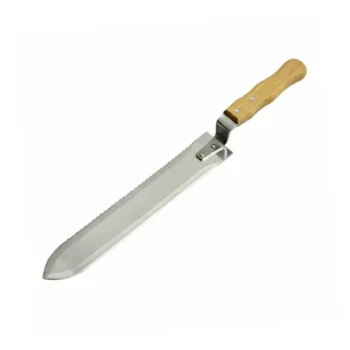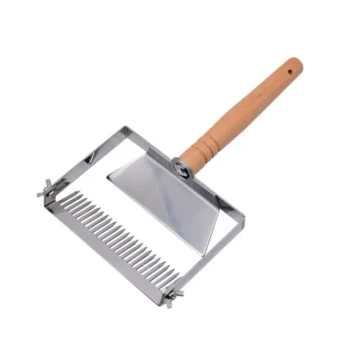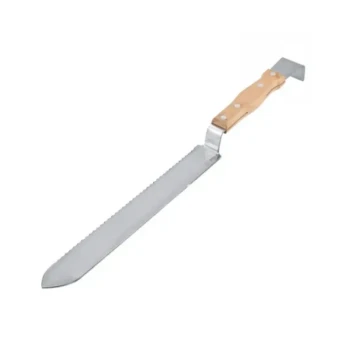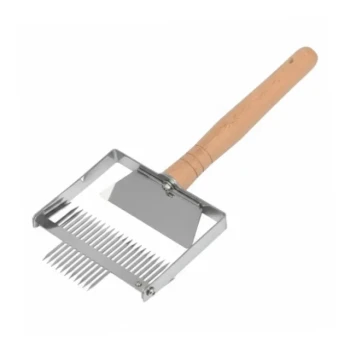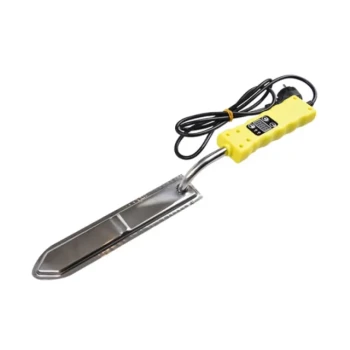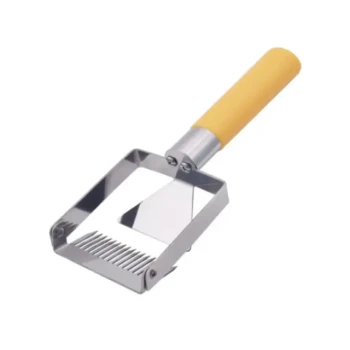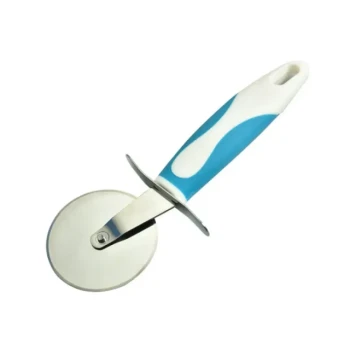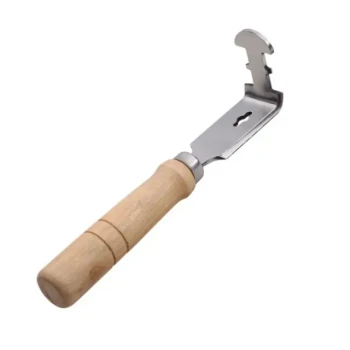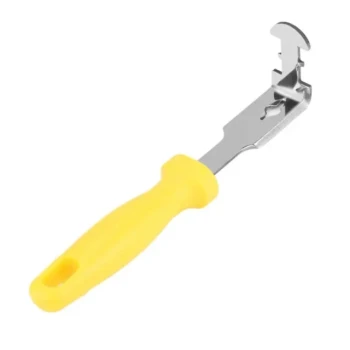To remove wax caps from a honeycomb frame, you must slice them off before placing the frame in an extractor. The standard method involves securing the frame on a pivot point, such as a nail driven through a board, and using a long, sharp uncapping knife with a steady sawing motion to cut just under the cappings. This process exposes the honey-filled cells, allowing centrifugal force to pull the honey out during extraction.
Uncapping is a critical step that directly impacts your honey yield and the long-term health of your comb. The goal is not simply to remove the wax, but to do so cleanly and efficiently, preserving the underlying comb structure for the bees to reuse.
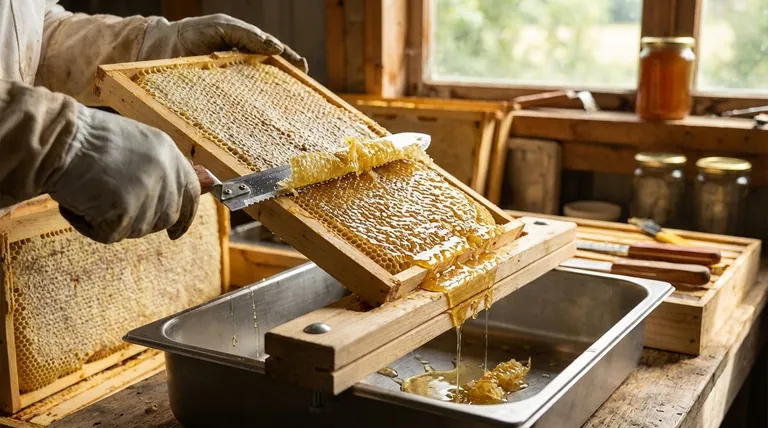
The Purpose of Uncapping
Before honey can be extracted, the protective wax seal that bees place over each filled cell must be broken. An extractor slings honey out of the cells using centrifugal force, which is impossible if the cells remain sealed.
Why Cappings Must Be Removed
The wax cappings create an airtight and watertight seal, preserving the honey indefinitely. For an extractor to work, these cells must be opened to allow the honey to fly out and collect on the walls of the extractor drum.
Preserving the Comb Structure
A clean, shallow cut is paramount. By only removing the cappings and not the deeper cell walls, you leave the majority of the comb intact. This saves the bees an immense amount of energy, as they can quickly repair and refill the existing structure rather than having to rebuild it from scratch.
Essential Tools and Setup
A proper workstation makes the uncapping process faster, cleaner, and more efficient. It consists of three key components: a stable frame holder, an uncapping tool, and a collection system.
The Frame Holder
The simplest and most effective holder is a piece of wood with a sharp nail driven up through it. The bottom bar of the frame rests on this nail, creating a stable pivot point that allows you to rotate the frame easily while keeping your hands free for the knife.
Choosing Your Uncapping Tool
You have several options, each with its own advantages.
- Uncapping Knife: This is the standard tool. It's a long, sharp blade designed for this purpose. They can be "cold" or heated electrically. An electric hot knife melts through the wax with exceptional ease.
- Serrated Bread Knife: For a beekeeper on a budget, a long, sharp bread knife is a surprisingly effective alternative. Its sawing action works well to slice through the cappings.
- Uncapping Fork/Scratcher: This tool has sharp tines used to pierce and lift cappings in low spots or recessed areas of the comb where a knife can't reach.
The Collection System
As you uncap, a mixture of wax and honey will fall away. You must have a basin or, ideally, a dedicated uncapping tank placed underneath your work area. This catches the valuable mixture, which is known as "cappings," for later processing.
The Uncapping Technique
With your setup prepared, the technique itself is straightforward. Focus on a smooth, controlled motion.
Position the Frame
Stand the frame vertically on its end bar, resting it on the nail pivot in your board. Tilt it slightly forward so the honey-laden cappings fall away from the frame and directly into your collection basin.
The Sawing Motion
Hold the frame securely with one hand. With the other, place your uncapping knife at the top of the frame, just under the top bar. Use a gentle, back-and-forth sawing motion to slice downwards, keeping the blade as flat as possible against the frame. Let the weight and sharpness of the knife do most of the work.
Handling Uneven Comb
If the comb surface is uneven, a knife may miss the cappings in lower areas. Use an uncapping fork or scratcher to manually pierce these missed cells, ensuring all honey is exposed before extraction.
Understanding the Trade-offs
The method you choose involves balancing speed, cost, and the quality of the finished comb.
Cold Knife vs. Hot Knife
A cold knife is simple, requires no power, and is inexpensive. However, if not kept razor-sharp, it can tear the comb rather than slicing it cleanly. An electric hot knife glides through wax effortlessly but is an added expense and requires a power source and careful handling to avoid burns.
The Risk of Cutting Too Deep
The most common mistake is angling the knife too deeply into the comb. This removes excess wax and honey, damages the comb structure that bees must rebuild, and mixes too much wax into your extracted honey. Aim for the thinnest possible slice that removes the cappings.
Preparing for the Mess
Uncapping is the stickiest part of honey harvesting. Honey and wax will get everywhere if you are not prepared. Work on a surface that is easy to clean, like a plastic tarp, and have everything you need within arm's reach before you begin.
Making the Right Choice for Your Goal
After uncapping, don't discard the wax and honey mixture in your basin. Let it drain through a sieve or cheesecloth to separate the liquid honey from the wax. The wax can then be washed and rendered into clean blocks for other uses.
- If your primary focus is cost-effectiveness: A sharp, serrated bread knife and a simple food-grade bucket and basin setup is a perfectly functional starting point.
- If your primary focus is speed and efficiency: Investing in an electric uncapping knife and a dedicated uncapping tank will dramatically accelerate your workflow, especially with multiple hives.
- If your primary focus is preserving perfect comb: Use a very sharp cold knife for a shallow cut and meticulously follow up with an uncapping fork to open any missed cells without damaging the underlying structure.
Executing this step with care and precision sets the stage for a successful and rewarding honey harvest.
Summary Table:
| Tool/Method | Best For | Key Consideration |
|---|---|---|
| Cold Uncapping Knife | Cost-effectiveness, preserving comb | Must be kept razor-sharp to avoid tearing |
| Electric Hot Knife | Speed, efficiency, ease of use | Requires power source; risk of burns |
| Serrated Bread Knife | Budget-friendly beekeepers | A good, sharp alternative to a dedicated knife |
| Uncapping Fork/Scratcher | Opening missed cells on uneven comb | Used for precision work after the main cut |
Ready to streamline your honey harvest?
For commercial apiaries and beekeeping equipment distributors, efficiency and comb preservation are critical for profitability. HONESTBEE supplies high-quality, durable uncapping knives, tanks, and extractors designed for heavy use.
We help you:
- Maximize Honey Yield: Our tools ensure a clean, shallow cut to preserve comb structure for faster bee recovery.
- Improve Operational Efficiency: Durable equipment built for speed reduces labor time during the busiest season.
- Scale Your Operation: Get the right equipment for your volume, from a single hot knife to a full uncapping setup.
Contact HONESTBEE today for wholesale pricing on the uncapping equipment that will make your next harvest your best one.
Visual Guide

Related Products
- Honeycomb Uncapping Knife for Apiculture
- Wide Adjustable Stainless Steel Honey Uncapping Fork with Scraper
- Stainless Steel Dual Blade Uncapping Plane
- Professional Z-Shaped Multi-Function Uncapping Knife for Beekeeping
- Electric Heated Honey Uncapping Knife for Beekeeping
People Also Ask
- How does comb depth affect the efficiency of uncapping tools? Match Your Tool for a Faster Harvest
- What is the benefit of the serrated edge on an uncapping knife? Unlock Faster, Cleaner Honey Extraction
- What is the use of uncapping knife in apiculture? Essential for a Clean, Efficient Honey Harvest
- What is the overall recommendation for beginner beekeepers regarding uncapping tools? Master Your First Honey Harvest
- What are some tools that can be used to remove wax cappings from honeycomb? Choose the Right Tool for Your Harvest Scale
